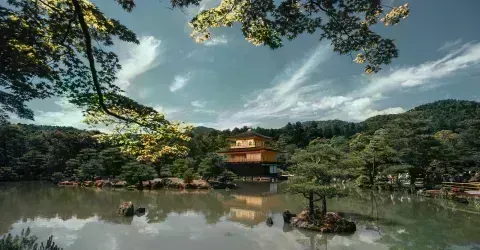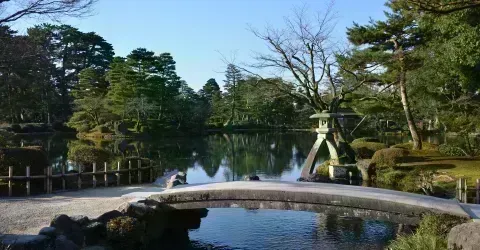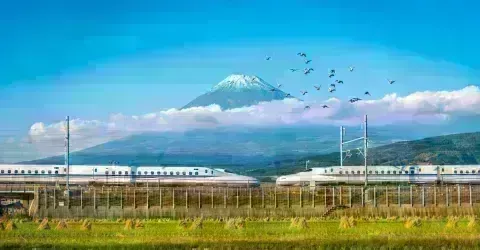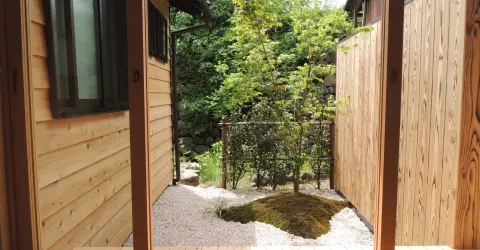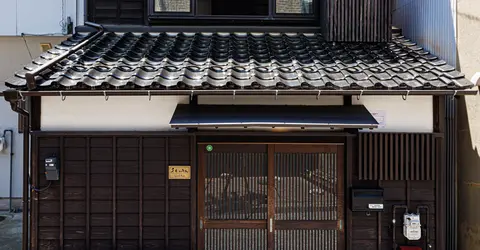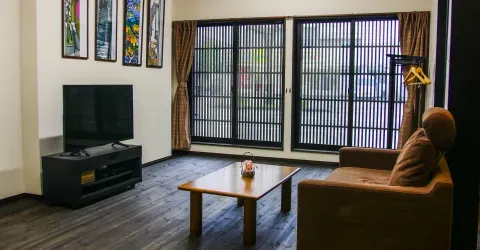Kanazawa Station 金沢駅
This distinct station hints at the spirit of the city. Farewells and reunions happen here every day, with passengers rushing through the crowds with their arms full, however they rarely take the time to look up and appreciate the beauty of this station's great architecture.
Kanazawa Station honors modernity while simultaneously embracing the city's storied past. Fresh off the train, travelers discover a huge glass dome over their heads, with infinite reflections. Inside the main building a shopping center satisfies the urges of buyers with clothing, souvenirs and local products. Most of the space is powered by solar panels located on the roof, thus making this the first Japanese ecological station.
But the heart of the station is outside. A huge torii (traditional Shinto gate marking the entrance to a shrine) stands four meters in height. Far from the usual red gate made of simple wooden cylinders, this monument is a feat of architectural technology. A modern design, with imposing yet graceful curves, goes along with this gigantism.
Opened in 2005, this adaptation of a traditional building also has a small square, with benches and flowerbeds of greenery to take a pleasant stroll through. Also of note is a fun fountain clock, consisting of small water jets that display the time as well as small messages welcoming you to Kanazawa!
Kanazawa is now easier to reach from Tokyo by Shinkansen, thanks to the Hokuriku branch that opened in March 2015.
Station Overview
There are four different lines operating out of Kanazawa Station, with three different railway companies. Kanazawa Station is predominetntly serviced by JR West, and is a major station on the Hokuriku Shinkansen Line. Formerly, Kanazawa was the terminus station for this bullet train line, however, in March of 2024, it was expanded out to the next pefecture over, Fukui, with the new terminus being Tsuruga. Komatsu Station, Kagaonsen Station, Awaraonsen Station, Fukui Station, Echizen-Takefu Station, and Tsuruga Station were all added as Shinkansen stops. Due to being a major JR Station, there is a Midori no Madoguchi customer service office here.
The other terminus for the Hokuriku Shinkansen is Tokyo Station, so there are high speed trains going to and from there throughout the day. Trains going out towards Toyama, Nagano, and Tokyo go from tracks 11 and 12. Going the other way out to Fukui are tracks 13 and 14.
Other major destinations easily accessible from Kanazawa Station include Takayama via way of transferring to the Hida Express from Toyama Station, and destinations in Kansai like Osaka and Kyoto. This is done by going out to Tsuruga with the Shinkansen and then transferring onto the Thunderbird Limited Express from there.
Kanazawa Station is also included as an access point for many travel passes available to visitors in Japan. The National Japan Rail Pass, of course, is one such pass, but more specific regional passes such as the Takayama-Hokuriku Pass and the Osaka-Tokyo Hokuriku Pass.
Tracks 1 though 7 are for local and other non high-speed trains that go throughout Ishikawa Prefecture as well as to other nearby prefectures, such as Toyama and Fukui via the IR Ishikawa Line. The Nanao Line goes out to the Noto Peninsula that extends out into the Sea of Japan. Notable destinations on this line include Hakui, Nanao, and Wakuraonsen.

@flickr/ Crispin Semmens
Between tradition and modernity
But the heart of the show lies at the exit. An immense torii (gateway marking the entrance to shrines) stands some fourteen meters high. Far from the usual vermilion gate made of simple wooden cylinders, this monument is a feat of architectural technology. Its modern design, with its imposing yet graceful curves, goes hand in hand with its gigantism.
Created in 2005, this adaptation of a traditional building stands in the middle of a small square adorned with benches and flowerbeds, where it's pleasant to stroll. Of particular note is the amusing clock fountain, made up of small jets of water that display the time and little messages to welcome you to Kanazawa!
Since March 14, 2015, it's been much easier to visit Kanazawa: the city is linked to Nagano and Tokyo by the Shinkansen Hokuriku line.
Nearby Kanazawa Station
One of the key features of Kanazawa City is how easily walkable it is. For those who are willing to stroll around a bit, most major destinations within the city center are, at most, within a 20-to-30 minute walk from each other. From Kanazawa Station, Omicho Fish Market, dubbed the "Kitchen of Kanazawa," is just 10 minutes on foot. A 15-minute walk from there in one direction leads to Kanazawa Castle, the next-door famous Kenroku-en Garden, and the 21st Century Contemporary Art Museum. Another 15-20 minute walk from there is the Higashicha-ya traditional tea district, made up of original historic buildings. During World War II, Kanazawa was left primarily untouched, making it a time capsule of historic Japan that simultaneously embraces modern sensibilities.





